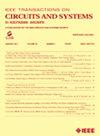BeaCIM: A Digital Compute-in-Memory DNN Processor With Bi-Directional Exponent Alignment for FP8 Training
IF 4.9
2区 工程技术
Q2 ENGINEERING, ELECTRICAL & ELECTRONIC
IEEE Transactions on Circuits and Systems II: Express Briefs
Pub Date : 2025-02-11
DOI:10.1109/TCSII.2025.3541101
引用次数: 0
Abstract
Previous digital Compute-In-Memory (DCIM) exhibits limitations in Deep Neural Network (DNN) training with FP8, which is playing an increasingly important role in model training. Most of the previous DCIM purely align exponents to the maximum one when computing floating-point data. This method struggles to balance accuracy and energy efficiency when using FP8. In this brief, we propose BeaCIM, a DCIM processor with bi-directional exponent alignment. There are several contributions. First, we propose a new exponent alignment mechanism, which can dynamically adjust the shared exponent用于FP8训练的双向指数对齐的数字内存计算DNN处理器
以往的数字内存计算(DCIM)在FP8深度神经网络(DNN)训练中表现出局限性,而深度神经网络在模型训练中发挥着越来越重要的作用。以前的大多数DCIM在计算浮点数据时纯粹将指数对齐到最大值。当使用FP8时,这种方法很难平衡精度和能源效率。在本文中,我们提出了一个双向指数对齐的DCIM处理器BeaCIM。有几个贡献。首先,我们提出了一种新的指数对齐机制,该机制可以动态地将共享指数$(E^{*})$调整到指数的数值分布中心。其次,我们使用乘积偏移(SOP)方法来解决数据位宽的限制,并提出了基于普通最小二乘(OLS)的$E^{*}$计算器。最后,我们进行了rtl级电路实现,并使用各种数据集和模型评估了BeaCIM。实验结果表明:(1)与标准混合FP8训练相比,我们的双向指数对齐FP8训练在不同模型和数据集上的平均前1准确率下降小于0.75%。(2)在FP8下,BeaCIM可以实现31.5 TFLOPS/W的能源效率,比最先进的产品高2.6- 19.3倍。
本文章由计算机程序翻译,如有差异,请以英文原文为准。
求助全文
约1分钟内获得全文
求助全文
来源期刊
CiteScore
7.90
自引率
20.50%
发文量
883
审稿时长
3.0 months
期刊介绍:
TCAS II publishes brief papers in the field specified by the theory, analysis, design, and practical implementations of circuits, and the application of circuit techniques to systems and to signal processing. Included is the whole spectrum from basic scientific theory to industrial applications. The field of interest covered includes:
Circuits: Analog, Digital and Mixed Signal Circuits and Systems
Nonlinear Circuits and Systems, Integrated Sensors, MEMS and Systems on Chip, Nanoscale Circuits and Systems, Optoelectronic
Circuits and Systems, Power Electronics and Systems
Software for Analog-and-Logic Circuits and Systems
Control aspects of Circuits and Systems.

 求助内容:
求助内容: 应助结果提醒方式:
应助结果提醒方式:


